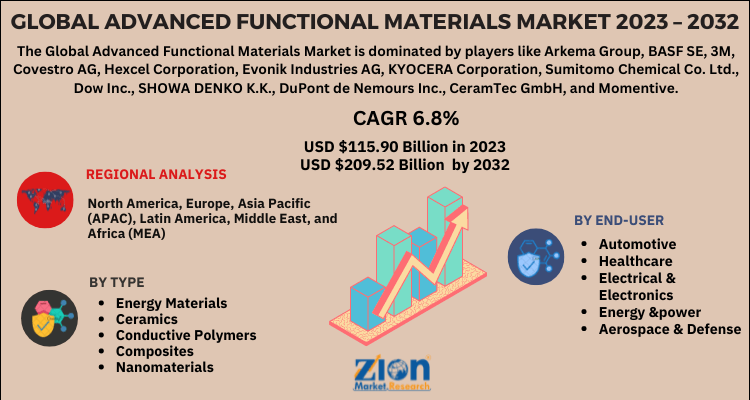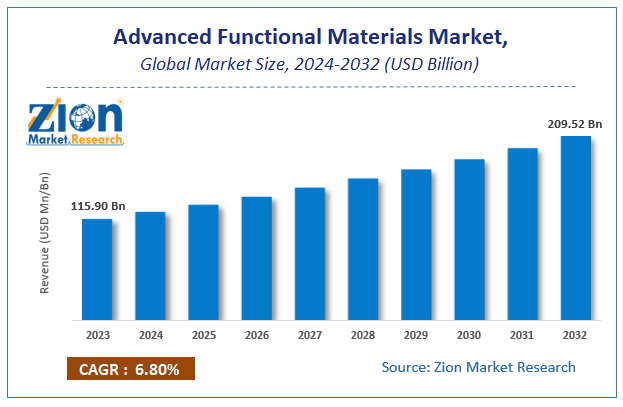Advanced Functional Materials Market Size, Share Report, Analysis, Trends, Growth 2030

Advanced Functional Materials Market By Type (Ceramics, Energy Materials, Conductive Polymers, Nanomaterials, Composites, and Others), By End-user Industry (Electrical & Electronics, Automotive, Healthcare, Aerospace & Defense, Energy & Power, and Others), and By Region - Global and Regional Industry Overview, Market Intelligence, Comprehensive Analysis, Historical Data, and Forecasts 2022 - 2028-
| Market Size in 2023 | Market Forecast in 2032 | CAGR (in %) | Base Year |
|---|---|---|---|
| USD 115.90 Billion | USD 209.52 Billion | 6.8% | 2023 |
Description
According to the report published by Zion Market Research, the global Advanced Functional Materials Market size was valued at USD 115.90 Billion in 2023 and is predicted to reach USD 209.52 Billion by the end of 2032. The market is expected to grow with a CAGR of 6.8% during the forecast period. The report analyzes the global Advanced Functional Materials Market's growth drivers, restraints, and impact on demand during the forecast period. It will also help navigate and explore the arising opportunities in the Advanced Functional Materials industry.
Industry Prospective:
The global advanced functional materials market is estimated to grow with a compound annual growth rate (CAGR) of approximately 7.9 percent over the forecast period. The report analyzes the advanced functional materials market’s drivers, restraints/challenges, and the effect they have on the demands during the projection period. In addition, the report explores emerging opportunities in the advanced functional materials market.
Advanced Functional Materials Market: Overview
Advanced functional materials are high-quality compounds with characteristics such as strong mechanical strength, flexibility, corrosion resistance, and thermal & chemical stability. Advanced functional materials encompass a diverse range of materials, including ceramics, composites, nanomaterials, and conductive polymers. Advanced functional materials offer a wide variety of applications in several end-use sectors, including electronics, healthcare, aircraft, automobiles, and others, due to their better qualities.
COVID-19 Impact:
Manufacturing facilities in most of the nation have been closed as a result of the COVID-19 outbreak. As a result of this, demand for advanced functional materials, particularly conductive polymers, and nanomaterials have decreased significantly, limiting the market's worldwide expansion. Furthermore, sophisticated functional materials are widely used in the electric and electronics, as well as the automotive sectors. Smartphones and other electronic gadget output fell dramatically in 2020. Furthermore, because of the pandemic crisis and the suspension of manufacturing facilities, automotive output in 2020 was reduced by nearly 15 percent more than in 2019.
Advanced Functional Materials Market: Report Scope
| Report Attributes | Report Details |
|---|---|
| Report Name | Advanced Functional Materials Market |
| Market Size in 2023 | USD 115.90 Billion |
| Market Forecast in 2032 | USD 209.52 Billion |
| Growth Rate | CAGR of 6.8% |
| Number of Pages | 205 |
| Key Companies Covered | Arkema Group, BASF SE, 3M, Covestro AG, Hexcel Corporation, Evonik Industries AG, KYOCERA Corporation, Sumitomo Chemical Co. Ltd., Dow Inc., SHOWA DENKO K.K., DuPont de Nemours Inc., CeramTec GmbH, and Momentive |
| Segments Covered | By type, By end-user and By Region |
| Regions Covered | North America, Europe, Asia Pacific (APAC), Latin America, Middle East, and Africa (MEA) |
| Base Year | 2023 |
| Historical Year | 2018 to 2022 |
| Forecast Year | 2024 - 2032 |
| Customization Scope | Avail customized purchase options to meet your exact research needs. Request For Customization |
Advanced Functional Materials Market: Growth Drivers
Increasing demand from the aerospace and defense industry is expected to boost market growth.
During the projected period, the aerospace and defense industry is likely to be one of the leading users of advanced functional materials. Nanotechnology allows for advancements in nuclear, biological, and chemical detection, which are useful in military and defense applications. Additionally, using nanotechnology reduces military staffing requirements and reduces battlefield hazards for troops, as well as improves vehicle performance.
The worldwide aerospace sector is expected to develop significantly through 2019 as a result of increased investments and aircraft orders, propelling the global advanced functional materials market demand. However, due to the pandemic crisis, investments and demand for air travel have decreased in 2020, triggering a market downturn. However, with the occurrence of pre-pandemic conditions, the industry is expected to rise dramatically.
 Request Free Sample
Request Free Sample
Advanced Functional Materials Market: Restraints
High price of the end products which combine advanced functional materials may hinder the market growth.
The relatively high price of final goods that contain advanced functional materials is projected to impede global demand for advanced functional materials, particularly in emerging and developing countries. In addition to this, the lack of infrastructure development as well as technology in underdeveloped countries has led to low penetration of the market in these regions. Further, the growth of advanced functional material market participants is projected to be hampered by a lack of expansion capacity to fulfill market demand.
Advanced Functional Materials Market: Opportunities
Increasing application of advanced functional materials in the electrical & electronics industry is likely to provide better growth opportunities to the market.
In the near future, the global advanced functional materials market is likely to benefit from an increase in demand for advanced functional materials in the electrical and electronics industry. Advanced functional materials are used in a variety of applications in the electronics industry, including the manufacture of high-energy-density capacitors, batteries, supercapacitors, and other items. Moreover, to develop lightweight and efficient cars and aircraft, some new functional materials are also employed in the automotive and aerospace sectors.
Advanced Functional Materials Market: Challenges.
Low penetration of advanced functional materials in industries operating in low-income countries poses a major challenge for the market.
Due to its high requirement of manufacturing sophistication, its use in an industrial environment where cost is the major factor becomes less. Advanced functional materials require sophisticated manufacturing units to ensure the quality of the materials which low-income countries still cannot afford. Also, the import of such materials for several industries use restricts due to its high cost which ultimately increases the prices of the final product. Such parts or devices combined with advanced functional materials are also facing low penetration in the local market. All these factors are the major challenge for advanced functional materials manufacturers.
Advanced Functional Materials Market: Segmentation
The global advanced functional materials market is categorized based on type, end-user, and region.
Based on type, the market is bifurcated into energy materials, ceramics, conductive polymers, composites, nanomaterials, and others.
The end-user segment of the market is segregated as automotive, healthcare, electrical & electronics, energy &power, aerospace & defense, and others.
Recent Developments
In March 2022, Mitsubishi Corporation and Toyobo Co., Ltd. have announced that they have agreed to form a new joint venture company to focus on the planning, research, manufacture, and marketing of functional materials.
Advanced Functional Materials Market: Regional Landscape
Asia Pacific to lead the global market during the forecast period.
Asia Pacific region is expected to have the largest market share in the global advanced functional materials market. The region will lead the market with over 40 percent of the shares. The existence of manufacturing-based economies in the region has resulted in high demand for innovative functional materials of various sorts. China, India, Japan, and South Korea's automotive, aerospace, and electrical & electronics sectors are expected to generate the bulk of demand for advanced functional materials in the Asia Pacific region. The demand for advanced functional materials is expected to be highest in Asia Pacific, followed by North America and Western Europe.
Advanced Functional Materials Market: Competitive Landscape
Key players functioning in the global advanced functional materials market include
- Arkema Group
- BASF SE
- 3M
- Covestro AG
- Hexcel Corporation
- Evonik Industries AG
- KYOCERA Corporation
- Sumitomo Chemical Co. Ltd.
- Dow Inc.
- SHOWA DENKO K.K.
- DuPont de Nemours Inc.,
- CeramTec GmbH
- Momentive.
The Global Advanced Functional Materials Market segments are as follows:
By type
- energy materials
- ceramics
- conductive polymers
- composites
- nanomaterials
- others.
By end-user
- automotive
- healthcare
- electrical & electronics
- energy &power
- aerospace & defense
- others.
Global advanced functional materials market is segmented as follows:
By Type
- Ceramics
- Energy Materials
- Conductive Polymers
- Nanomaterials
- Composites
- Other
By End User
- Electrical & Electronics
- Automotive
- Healthcare
- Aerospace & Defense
- Energy & Power
- Other
By Region
- North America
- The U.S.
- Canada
- Europe
- France
- The UK
- Spain
- Germany
- Italy
- Rest of Europe
- Asia Pacific
- China
- Japan
- India
- South Korea
- Southeast Asia
- Rest of Asia Pacific
- Latin America
- Brazil
- Mexico
- Rest of Latin America
- Middle East & Africa
- GCC
- South Africa
- Rest of Middle East & Africa
What Reports Provides
- Full in-depth analysis of the parent market
- Important changes in market dynamics
- Segmentation details of the market
- Former, on-going, and projected market analysis in terms of volume and value
- Assessment of niche industry developments
- Market share analysis
- Key strategies of major players
- Emerging segments and regional markets
- Testimonials to companies in order to fortify their foothold in the market.
Table Of Content
Choose License Type
List of Contents
Industry Prospective:OverviewCOVID-19 Impact:Report ScopeGrowth DriversRestraintsOpportunitiesChallenges.SegmentationRecent DevelopmentsRegional LandscapeCompetitive LandscapeThe Global Market segments are as follows:Global advanced functional materials market is segmented as follows:What Reports ProvidesFrequentlyAsked Questions
Increasing demand from the aerospace and defense industry is expected to boost market growth. During the projected period, the aerospace and defense industry is likely to be one of the leading users of advanced functional materials. Nanotechnology allows for advancements in nuclear, biological, and chemical detection, which are useful in military and defense applications. Additionally, using nanotechnology reduces military staffing requirements and reduces battlefield hazards for troops, as well as improves vehicle performance. The worldwide aerospace sector is expected to develop significantly through 2019 as a result of increased investments and aircraft orders, propelling market demand. However, due to the pandemic crisis, investments and demand for air travel have decreased in 2020, triggering a market downturn. However, with the occurrence of pre-pandemic conditions, the industry is expected to rise dramatically.
According to the Zion Market Research report, the global advanced functional materials market is predicted to grow with a compound annual growth rate (CAGR) of around 7.9 percent.
Asia Pacific region is expected to have the largest market share in the global advanced functional materials market. The region will lead the market with over 40 percent of the shares. The existence of manufacturing-based economies in the region has resulted in high demand for innovative functional materials of various sorts. China, India, Japan, and South Korea's automotive, aerospace, and electrical and electronics sectors are expected to generate the bulk of demand for advanced functional materials in the Asia Pacific region.
Key players functioning in the global advanced functional materials market include Arkema Group, BASF SE, 3M, Covestro AG, Hexcel Corporation, Evonik Industries AG, KYOCERA Corporation, Sumitomo Chemical Co. Ltd., Dow Inc., SHOWA DENKO K.K., DuPont de Nemours Inc., CeramTec GmbH, and Momentive.
HappyClients
Zion Market Research
Tel: +1 (302) 444-0166
USA/Canada Toll Free No.+1 (855) 465-4651
3rd Floor,
Mrunal Paradise, Opp Maharaja Hotel,
Pimple Gurav, Pune 411061,
Maharashtra, India
Phone No +91 7768 006 007, +91 7768 006 008
US OFFICE NO +1 (302) 444-0166
US/CAN TOLL FREE +1 (855) 465-4651
Email: sales@zionmarketresearch.com
We have secured system to process your transaction.
Our support available to help you 24 hours a day, five days a week.
Monday - Friday: 9AM - 6PM
Saturday - Sunday: Closed






